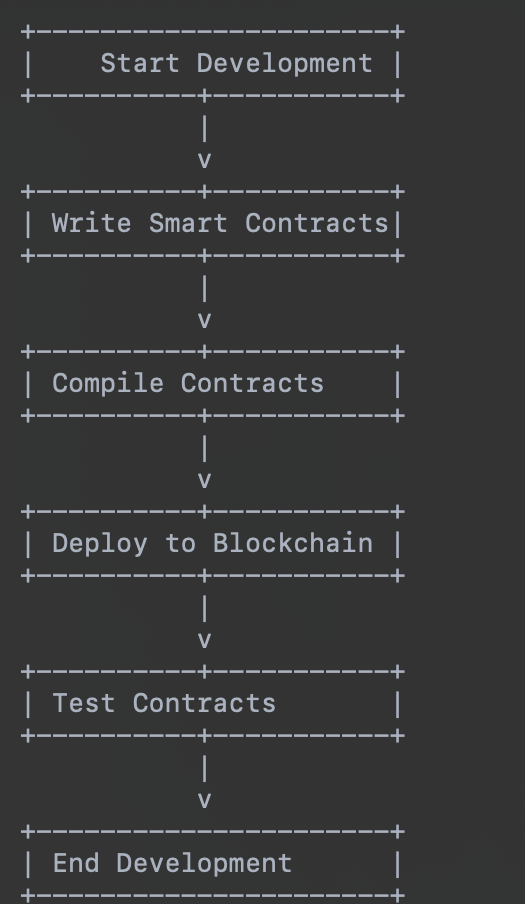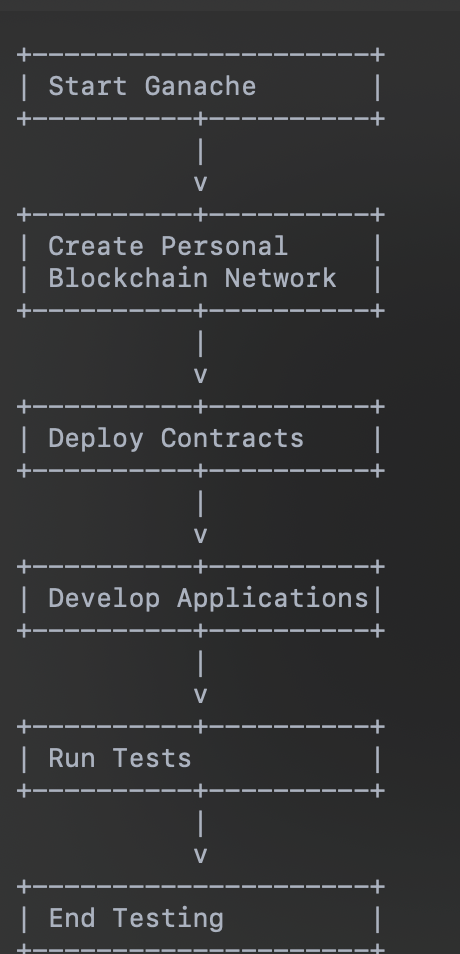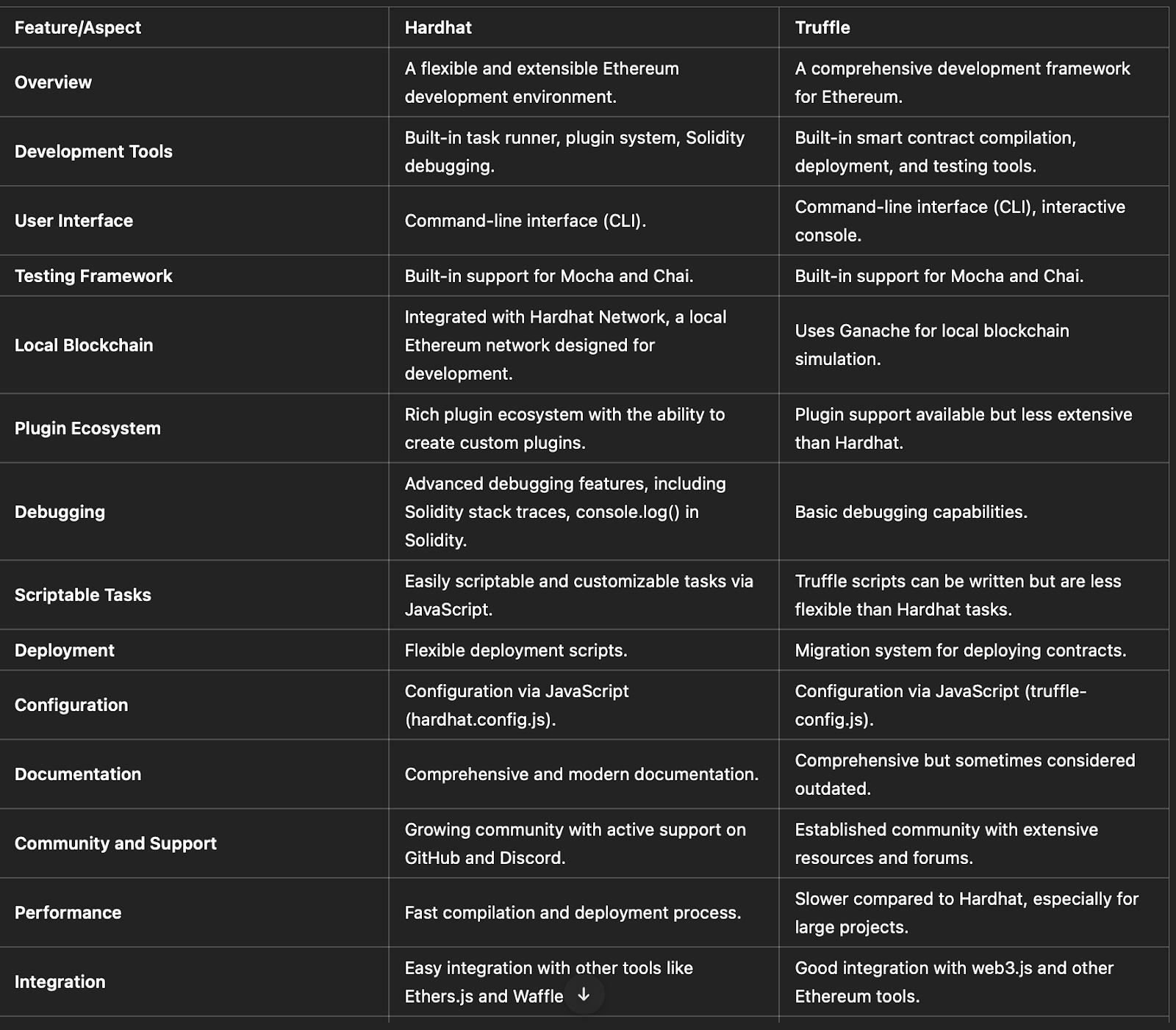Introduction
Blockchain is rapidly evolving, and so is its development domain. New tools and frameworks are emerging to make the process smoother and give developers more options and ease. This article will explore the key tools and frameworks that make blockchain development much easier, more productive, and more reliable.
We’ll look at everything from development setups to decentralized storage answers, covering the hands-on, developer-focused tools you can only do with if you want to build on blockchain technology.
Development Environments
Development environments provide a holistic package for the developers to showcase their creativity.
Truffle is a complete environment package for building, testing, and deploying smart contracts. The Truffle Suite consists of three main components: Truffle, Ganache, and Drizzle.
Truffle: It is a development framework that provides a set of tools for the development, compilation, linking, and deployment of smart contracts.
Workflow:

Ganache: A personal blockchain for Ethereum developers. It is used to deploy contracts, develop applications, and run tests.


Drizzle: Drizzle is a front-end library that integrates smart contracts with front-end applications.


- Use cases and benefits for smart contract development
Truffle Suite streamlines the process for developers, making it simpler to handle and check smart contracts. It also boosts productivity by offering a full-featured development setting with many tools.
- Installation and setup instructions.
Pre-requisite is to have node.js installed on your system.
Hardhat is a popular choice among developers due to the features it offers like flexibility and extensibility. Also, it has an integrated task runner, and network management ability, and can extend its functionalities through plugins.
Comparison with Truffle.
Truffle is a comprehensive suite whereas Hardhat is known for its flexibility and ease of plugin integration.


- Installation and setup guide:
| npm install –save-dev hardhat |
Integrated Development Environments (IDEs)
Remix is an online IDE that simplifies the code’s writing process and compiles and deploys the contracts. It has a lot of built-in debugging tools, and its integration with the Ethereum network makes it a go-to for developers.
- A step-by-step guide to setting up and using Remix.
- Make sure you have the prerequisites Node.js and npm already installed
- Create a new Remix App: npx create-remix@latest
- Set up the projects and packages
- Navigate to the project directory
- Install dependencies
- Run the development server: npm run dev
- Explore the project structure
- Add a new route
- Deploy your remix app
- Visual Studio Code (VS Code)
As we know VS code is such a versatile IDE and the most preferred one among all types of developers no doubt it needs to be on this list. The recommended extensions for the same are Solidity and Ethereum Debugger.
Install the Solidity extension for syntax highlighting and debugging support and configure the Ethereum Debugger to test and deploy the smart contracts seamlessly.
Testing Frameworks
Mocha and Chai are essential for testing the contracts in JavaScript. Mocha is a test framework and Chai is an assertion library both in unison help in running tests and writing test assertions.
- Writing and running tests with practical examples.
Waffle is a testing framework that seamlessly integrates with Hardhat. It provides advanced testing abilities and have comprehensive assertions.
- Writing tests with Waffle.
Blockchain Networks
As we know, networks are the connections of the nodes, or in other words, the devices participating in the blockchain.
Ethereum network is widely used for smart contract deployment.
- Setting up a private Ethereum network using Geth.
- Run the following commands:
| geth –datadir ./private-chain init genesis.json geth –datadir ./private-chain –networkid 1234 console |
Deploy the contracts using Truffle or Hardhat and connect it to your private blockchain network with appropriate configurations.
Hyperledger is a private blockchain with restricted access designed for enterprise use.
- Setting up a local Hyperledger Fabric network.
- Make sure you have Docker, Go language and node.js already installed
- Install Hyperledger : curl -sSL https://bit.ly/2ysbOFE | bash -s
- Navigate to the Fabric Samples: cd fabric-samples
- Start the test network: cd test-network
./network.sh up
- Developing and deploying chaincode (smart contracts) on Hyperledger Fabric.
- Chaincode development: Write your chain code in Go, javascript or java.
- Package the chain code using peer CLI tool
- Install the Chaincode peers
- Approve the Chaincode definition
- Invoke and Query the Chaincode
Here are two popular development tools:
Infura Infura offers robust infrastructure to link up with the Ethereum network. Infura makes it easy to connect to Ethereum providing dependable and expandable API services.
- Steps to create an Infura project and deploy contracts.
- Set up a project on Infura
- Get the project ID
- Set your deployment scripts to use Infura endpoints.
Alchemy is another strong tool to connect to Ethereum giving developers advanced tools. Alchemy comes with extra features like instant alerts and in-depth analytics.
- Guide to using Alchemy for smart contract deployment.
- Join Alchemy,
- Make a new app
- Put the given API key in your deployment scripts.
Smart Contract Libraries
Smart contract libraries are sets of code you can use again and again. They offer common features and tools to help build smart contracts
OpenZeppelin is a library of secure and community-vetted contracts.It makes sure your contracts are protected.
- Integrating OpenZeppelin contracts into your projects.
| npm install @openzeppelin/contracts |
Ether.js is a lightweight library for front-end and backend interactions with Ethereum.
- Practical examples of interacting with smart contracts using Ether.js.
Block Explorers
As the name suggests, block explorers are the online search engine equivalents you can use to search for information about the blockchain and its transactions in real-time or in the past.
- Etherscan
- Etherscan is used to monitor transactions, debug smart contracts, and analyze blockchain data.
- Features and tools provided by Etherscan for developers:
Etherscan provides the APIs as a part of Developer tools so that you can access the blockchain data programmatically also.
BlockCypher is used for blockchain analytics and monitoring services. It supports multiple blockchains and provides a suite of developer tools.
- Using BlockCypher for blockchain analytics and monitoring.
- Sign up for an API key
- Use BlockCypher’s endpoints to access blockchain data and analytics.
Decentralized Storage Solutions
IPFS is a protocol for decentralized storage. It allows you to store file sand ensures decentralization and integrity
- Steps to integrate IPFS with blockchain applications.
Install the IPFS and use its API to add and retrieve files:
npm install ipfs-http-client
Filecoin is a distributed storage network built on IPFS. It gives people reasons to store stuff, making it a strong storage solution that’s not controlled by one group.
- Guide to using Filecoin for decentralized storage.
Get a Filecoin node up and running, and use the Filecoin API to work with the network.
- MythX
- MythX is a security analysis tool that performs security scans in your smart contracts.
- Steps to integrate MythX into the development workflow.
- Sign up for MythX,
- configure your project
- run scans to identify
- fix security issues.
- Slither
- Slither looks for bugs in Solidity contracts. It’s a tool that doesn’t run the code but checks it for problems. Slither checks your code to find common safety issues. It also gives ideas to make your code better.
- Using Slither for detecting vulnerabilities in smart contracts.
| pip install slither-analyzer slither . |
Continuous Integration/Continuous Deployment (CI/CD)
- GitHub Actions
- GitHub Actions lets you set up CI/CD for blockchain stuff.
- Setup:
- Make a workflow file to lay out your CI/CD pipeline. This file should say what actions to take to build, check, and put your contracts out there.
- Examples of CI/CD pipelines for smart contract deployment.
- CircleCI
- CircleCI is another way to do CI/CD that works well with blockchain projects.CircleCI gives you fancy options to make deploying happen on its own.
- Configuration:
- Make a config.yml file to spell out your pipeline steps. This helps to put your blockchain projects into action.
Case Studies and Real-world Applications
Some real-world applications are Ethreum in the DeFi space. The projects like Uniswap, Compound, and Avae utilized the above-mentioned framework. The key take is that security is paramount and risk mitigation, also testing is critical hence make sure rigorous testing is conducted and consider scalability.
Another such example is Hyperledger in Supply chain management with features like interoperability, user-friendly interface, and clear governance models to ensure accountability.
Conclusion
Blockchain coding is cool but tough. You need the right gear and systems to do well. Try these tools and start your trip to become a good blockchain coder. This field needs you to have skills and know-how to succeed. With these tools, you can make your work easier and create better apps. So go ahead, give them a shot, and see how they can help you grow as a blockchain pro. Happy Coding!!
Also Check Out: Build Your Own Blockchain: A Step-by-Step Guide for Beginners
Disclaimer and Risk Warning
The information provided in this content by Coinpedia Academy is for general knowledge and educational purpose only. It is not financial, professional or legal advice, and does not endorse any specific product or service. The organization is not responsible for any losses you may experience. And, Creators own the copyright for images and videos used. If you find any of the contents published inappropriate, please feel free to inform us.
Was this writing helpful?
No Yes
Credit: Source link